-

人教版新目标初中英语九年级上册Where would you like to visit教案2篇
The First PeriodⅠ.Teaching Aims and DemandsKnowledge Objects(1) Key Vocabularytiring, educational, fascinating, thrilling, peaceful, exotic, trek, jungle, take it easy, explore, historic, site(2) Target LanguageWhere would you like to go on vacation?I’d like to trek through the jungle, because I like exciting vacations.2. Ability Objects(1)Train students to talk about places they would like to visit with the target language.(2)Train students to describe vacations with different adjectives.(3)Train students' listening skill.3. Moral Object,It′s more interesting to go on vacating somewhere instead of staying at home.Ⅱ. Teaching Key Points1. Key Vocabularytiring, educational, fascinating, thrilling, peaceful, exotic, trek, jungle, take it easy, explore, historic, site2. Target LanguageTalk about different places with the target language.Ⅲ. Teaching Difficult Points1. Describe vacations with different adjectives.2. Talk about different places with the target language.Ⅳ. Teaching Methods1. Teaching by illumination2. Teaching by doing chain drills3. Teaching by pairworkⅤ. Teaching Aids1. A tape recorder2. Some pictures of different places with famous views

人教版新目标初中英语九年级下册Rainy days make me sad教案
1. 教材分析本单元以how do things affect you?为话题, 从颜色、天气、音乐、广告、产品等方面谈论了外界事物如何影响人的心情。要求学生掌握表达某物或某事给人带来的感觉、看法或影响等。共设计了四个部分的内容:Section A 该部分有4个模块:第一模块围绕Which restaurant would you like to go to?这一话题展开思维(1a)、听力(1b)、口语(1c)训练;第二模块围绕How does music affect you? 进行听力(2a-2b)、口语训练(2c);第三模块继续围绕how do colors in the restaurant affect you这一话题展开训练,训练形式为阅读和问题体验(3a)和小组活动(3b);第四模块仍就How do things affect you这一话题以调查的形式展开讨论。Section B该部分有4个模块:第一模块围绕产品广告对人们的影响这一话题以“配对”(1a)与“列举”(1b)两种形式展开训练;第二模块继续围绕How do things affect you? 进行听力(2a-2b)、口语对话训练(2c);第三模块围绕“Advertising”这一话题展开阅读(3a-3b)和写作(3c)训练;第四模块围绕How posters affect you这一话题以口语训练形式展开小组活动。

人教版新目标初中英语九年级下册Could you please tell me where the restrooms are教案
Step Ⅰ RevisionCheck homework. Ask a few students to read the article in 3a.Then ask a few students to read their guides.Step Ⅱ Part 1Look at the words in the box. Ask a student to read them. Make sure the students understand the meaning of the words. You are to fill in the blanks with the words. In some cases, students may need to use another form of the word, for example adjusting for tense or subject/ verb agreement.Ask students to fill in the blanks on their own.Check the answers. Step ⅢPart 2Go through the instructions with the class.Look at the example with the students.Ask students what the answer would be.Ask a student to read the question and answer it.Excuse me, could you tell me where the bank is, please?The bank is across the street from the shopping malt.Get students to complete the work in pairs.Check the answers. Ask a few students to read their questions.Step Ⅳ Just for Fun!Ask all the students to read the conversation. Ask: What is funny about this cartoon? Help students to explain. A Martian is a person from the planet Mars.There is no such thing as Martian food on Earth, and the clerk looks silly because he is trying to think of where there is a Martian restaurant.Invite some pairs of students to present this conversation to the rest of the class.Step Ⅴ Summary and HomeworkIn this class, we’ve done much writing practice using the key vocabulary words and the target language presented in this unit. After class, please finish the questions in 2 in your exercise books. Then finish the exercises on pages 47~48 of the workbook as well.The Seventh Period Ⅰ Teaching Aims and Demands1. Knowledge Objects(1) Key Vocabularyimage, adventure, jealousy, hero, crime, journey, brave, no longer, show interest in, take it easy, become interested in, plain looks(2)Text:Grown-ups like cartoons, too.2. Ability Objects(1) Fast-reading to get a general idea of the text.(2) Careful-reading to get the detailed information in the text.

人教版新目标初中英语九年级下册I’ll help clean up the city parks教案
Talk about offering help (P60)I’ll help clean up the city parks.A: I’d like to work ...B: You could help ...Talk about ways to tell people about the Clean-Up Day (P61)We need to ...We can’t ...I’ll ...Talk about the work the volunteers do (P62)These three students all volunteer their time to help other people.Somebody loves to ... / helps ... / plans to ... / wants to ...A: What do you like doing?B: I like ... A: What kind of volunteer work do you think I could do?B: You could ...1. 重点词汇advertisement, fix, repair, pleasure, blind, deaf, shut, carry, specially, fetch2. 认读词汇hunger, homeless, cheer, clean-up, sign, establish, major, commitment, elementary, veterinarian, coach, similar, call-in, strategy, disabled, organization, unable, support, appreciate, donation, part of speech, pronoun, adverb, preposition, conjunction, donate, Jimmy, Sally3. 词组clean up, cheer up, give out, put off, set up, think up, take after, fix up, give away, put up, hand out, work out, at once

人教版新目标初中英语九年级下册We’re trying to save the manatees教案2篇
本单元主要围绕着有关濒临灭绝的动物这一话题,学习了应该怎样保护我们的环境,以及就某一问题展开辩论。目标提示语言目标能够运用所学知识,就某一问题展开辩论。认知目标1、复习一些语法:现在进行时、一般现在时、用used to 表示一般过去时、现在完成时、一般过去时的被动语态。2、学会表达同意和不同意。3、学会以下基本句型:We’re trying to save the manatees.Manatees eat about 100 pounds of food a day.There used to be a lot of manatees.In 1972,it was discovered that they were endangered.Some of the swamps have become polluted.情感目标了解一些濒临灭绝的动物的生活习性和濒临灭绝的原因,教育学生应该如何保护环境。教学提示充分利用多媒体等教学设备,创设与本课话题相关的情境,如各种不同种类的动物、动物园以及有关环境的画画等等。围绕着本单元的教学目标,设计一些贴近学生实际的教学任务,如让学生谈论自己最喜欢的动物,如何拯救濒危动物,如何保护环境等等。让学生根据所学知识,就动物园是否对动物有利以及其他的话题进行辩论。

人教版新目标初中英语九年级下册You’re supposed to shake hands教案
教学目标:1. 掌握本单元一些重点词汇的写法和用法。2. 学会自如谈论餐桌礼仪。Step 1 RevisionAsk some students to retell the customs at the table in France in the passage in 3a.Step 2 Self checkPart 1. Fill in each bland with the correct word given. Students do the exercises by themselves at first. Then check the answers. Ask the students to comprehend the sentences and help them point out uses of some words, like “arrive (at / in) sw., spend time / money on sth , spend time / money (in) doing sth.”Part 2. Read about Fan Ling’s experience in a western restaurant. Understand the passage. Point out some key points in the passage.1. be / get used to doing sth. 习惯做某事2. begin with = start with 以….开头3. crowd v. 挤满,塞满 the crowd 人群 crowded adj. 拥挤的Then students discuss about how she would solve her problem. Ask some to share their stories with others.Part 3. Complete the crossword by looking at the sentences on the left. Then check the answers.

人教版新目标初中英语七年级上册What’s this in English教案
一、知识和能力目标本单元的核心教学内容是“认物”。用英语确认周围的常见事物比较符合英语初学者的实际情况。通过本单元教学,使学生运用所学句型,去熟悉周围事物的名称;教学生学会在实际生活中如何确认事物。通过辨认物体,学生学到一些生词,并巩固所学句型。二、过程和方法目标教师要尽量使学生对课文中出现的句型能够熟练上口,这样,学生才能顺利开展比较灵活的对话。教师可以用手势,表情,动作等示意,帮助学生听懂课堂教学内容,但在实际操作中应尽量避免“明知故问”的倾向,应该采用应用性原则;如:遮盖物品、显露局部、辨认物体、完形识别、图形辨认等方法。三、情感态度和价值观目标目标在学生学习过程中的作用至关重要,教师要帮助他们建立起一个切合自己实际的目标,通过渐进的学习以及一点一滴的进步,使他们逐步建立起成功感。成功越多,自信心就越强。

人教版新目标初中英语七年级下册It’s raining教案2篇
1 Each group choose one place to describe and what you are doing in it Choose one place, and describe what they are doing 2 Move around the room and give suggestions Talk about it and write it down 3 Ask one to show their works and act it Choose one of each group to make a report 4 Evaluate the best group and the best reporter Choose the best one Homework Ask your friends their ideal place and write about it教学反思:新课程标准中强调学生在课堂中的主体地位,在综合课中他们的主体地位就更加突出。在各个活动中给不同程度的学生不同层次的任务,让各层面的学生都有表现发挥的机会,从而产生对英语的兴趣。使用照片图片多媒体来辅助教学,效果更好。同时让了解其他国家风景,风俗的同学介绍ideal place,增加学生的背景知知识,实现跨学科交流的目的。教案点评:采用任务型教学模式,在各个活动中给不同程度的学生不同层次的任务,让各层面的学生都有表现发挥的机会,从而产生对英语的兴趣。使用照片图片多媒体来辅助教学,效果更好。让了解其他国家风景,风俗的同学介绍ideal place,增加学生的背景知识,实现跨学科交流的目的。

人教版新目标初中英语八年级上册How do you make a banana milk shake教案2篇
1. First, ... then, ... next, ... finally, ...首先,……然后,……接着,……最后,……这是英语中表达做某事的步骤的一种说法。如果步骤较多,还可以说:first-next-after that-later on-finally/at last通常你会听到说英语国家的人在说 first, next, then, finally 和后面的内容时,他们会做一些停顿。这样就能提前告诉听者接下来讲的是一系列的步骤。这一点在朗读和听力中应特别注意。2. how many, how much均为疑问词,同是“多少”,但用法不同。请看:how many修饰可数名词复数,how much修饰不可数名词。但在用法上,同学们常犯如下错误:1) [误] How many are there bananas on the table?[正] How many bananas are there on the table?[析] how many, how much 中的many,much是形容词,常修饰名词作定语,故后面跟名词。2) [误]How much tea are there on the table?[正]How much tea is there on the table?[析] how much修饰不可数名词时,谓语动词用单数。how many与how much的区别可简记为:前how many:问“多少”,复数名词后面跑;how much问“多少”,不可数名词单数好。前者答语用基数词,后者答语用数量关系。

人教版新目标初中英语八年级上册How was your school trip教案2篇
“Go for it!” is based on “Task-Based Language Teaching”. It adheres to “The authenticity principle”, “The form-function principle”, “The task dependency principle” and “The principle of learning by doing”. These principles all accord with the demands of curriculum focus.In and of Grade Seven (II), “Go for it!”, students have learned “The Simple Past Tense”. And it appears again in of Grade Eight (I). teaches students more about how to talk about events in the past. In addition, it gives affirmative and negative statements in the past tense, such as the sentence patterns “Did you see …?” “Were there …?” “Did you go …?” As the first part of Unit 8, Section A opens with a picture presenting the last school trip in the aquarium and continues with several step-by-step practice activities, which are all good for students to master “The Simple Past Tense”. Doing well in Section A will help students integrate the new target language with that in Section B. Thus, they can describe the events in the past freely and foster their own ability of reflecting and practicing. II. Teaching ObjectivesTeaching objective is the beginning and aim of teaching activities. According to the overall goal of the English elementary course--- improve students' synthetic ability of language application, which should be based on the development of students’ “Language knowledge”, “Language skills”, “Character building”, “Learning strategies” and “Cross-cultural awareness”. The teaching objectives are described as follows(I). Knowledge objectivesi. Master the simple past tense of regular and irregular verbsii. Recite the new words and expressions about the last school trip in the aquarium, including their pronunciation and intonation

人教版新目标初中英语八年级下册What should I do教案2篇
说明:在帮Li Lei提建议的同时,教育学生如何学好英语。第三课时教学目标1. 语言目标:a) 词汇: Original, in style, haircut, the same as.b) 语言结构:My friend wears the same clothes and has the same haircut as I do.2. 能力目标:大多数学生能够谈论自己喜欢哪种服装,提高查找信息的能力。3. 情感目标:学会如何与朋友相处,要有自己对时尚的看法。教学重点掌握一些重要词汇。教学难点学会谈论问题,并能提出书面建议。◆教学突破首先针对Erin的问题,提出个人的建议,模仿2c部分的对话展开双人交际Pair-work;听老师诵读3a部分的信件,并找出LEFT OUT的问题所在;学生完成3b部分的内容,给Left Out提出书面的建议;学以口头形式提出自己目前存在的某个问题,讲给大家听,让同学们给自己提出一个建议,并作笔录;学生两、三个人分成一组,随意性地进行口语交际,谈论P14的第4部分的某个问题,相互交换意见。

人教版新目标初中英语八年级下册If you go to the party, you’ll have a great time教案2篇
区分宾语从句、定于从句和状语从句宾语从句和状语从句,都叫做主从复合句。宾语从句主要是中考必考的,是初中阶段必掌握的从句,宾语从句主要是掌握三要素,所谓宾语从句,就是宾语在主从复合句当中充当宾语的一个句子,叫做宾语从句。主句的谓语动词是及物动词,后面如果是词或者是短语的话,是简单句,如果是句子的话,肯定是宾语从句。I know that he good at English.就是宾语从句,三要素,一要素是要注意连词,连词一共学了三类连词,一类连词是that口语当中可以省略,就像刚才说的那一句,I hear he is good at English.还有疑问代词、疑问副词,how where when,疑问代词、疑问副词。还有一类连词weather是否的意思,不是状语从句当中的如果,这一定要和如果区分开,这是是否。I don't know if he interested at English。宾语从句要注意if是连词。第二要素是语序,要用陈述举语序。比如说你家有几口人,我们都说How many people are there in you family?但是这是简单句,一旦说成宾语从句,你可以告诉我你家有几口人吗?Could you tell me how many people there are in you family ?
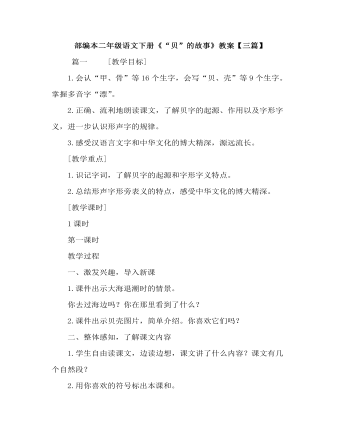
《“贝”的故事》教案
教学目标: 1、会认“甲、骨、类”等16个生字,会写“贴、街、扫”等9个生字,会写“贝壳、甲骨文、样子、可以、钱币、钱财、有关”等词语, 2、默读课文,了解贝字的起源,贝的作用以及字形字义。 一、激趣引入。 1、观察,说说你的发现。 (1)流、泪、河、江(2)说、话、记、读 (3)树、杨、李、林(4)购、货、赠、赚 2、说说你的发现。 生1:第一组的字都是“氵”,三点水的字都与水有关。 生2:第二组的字都是“讠”,言字旁的字都与说话有关。 生3:第三组的字都是“木”,木字旁的字都与树木有关。 生4:第四组的字都是“贝”,贝字旁的字都与钱有关。 3、师:孩子们真聪明,观察得非常仔细。今天,我们就要学习一篇与贝有关的课文。 4、揭示课题:3、贝的故事。
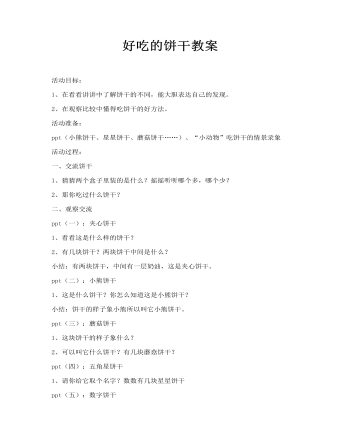
好吃的饼干教案
一、交流饼干1、猜猜两个盒子里装的是什么?摇摇听听哪个多,哪个少?2、那你吃过什么饼干?二、观察交流ppt(一):夹心饼干1、看看这是什么样的饼干?2、有几块饼干?两块饼干中间是什么?小结:有两块饼干,中间有一层奶油,这是夹心饼干。
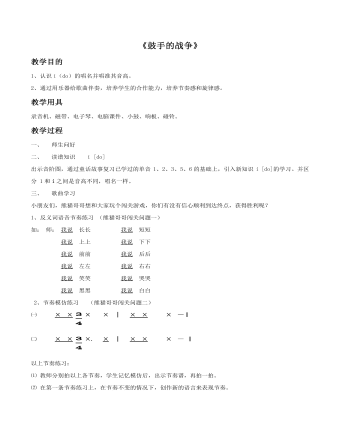
《鼓手的战争》教案
发声练习 ⑴根据以上节奏出示旋律。⑵师生一起识谱。⑶学生跟琴用“啦”模唱第二条旋律。⑷学生跟琴视唱谱。歌唱学习 ⑴范听第一遍,比比谁的耳朵灵。提问:a、 听听歌曲中使用了什么打击乐器? (小鼓) b、 歌曲讲了一个什么故事?⑵范听第二遍提问:你认为应该用什么情绪演唱?你能给这首歌取个名字吗?⑶出示歌谱,并给歌曲分句,请学生找出节奏相同的地方,再范听一遍。⑷有感情,有节奏的朗读歌词。(边拍边读)⑸学唱歌曲
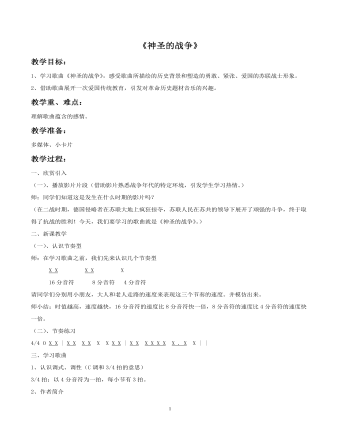
《神圣的战争》教案
一、欣赏引入(一)、播放影片片段(借助影片熟悉战争年代的特定环境,引发学生学习热情。)师:同学们知道这是发生在什么时期的影片吗?(在二战时期,德国侵略者在苏联大地上疯狂掠夺,苏联人民在苏共的领导下展开了顽强的斗争,终于取得了抗战的胜利!今天,我们要学习的歌曲就是《神圣的战争》。)二、新课教学(一)、认识节奏型师:在学习歌曲之前,我们先来认识几个节奏型 X X X X X 16分音符 8分音符 4分音符请同学们分别用小朋友,大人和老人走路的速度来表现这三个节奏的速度。并模仿出来。师小结:时值越高,速度越快,16分音符的速度比8分音符快一倍,8分音符的速度比4分音符的速度快一倍。(二)、节奏练习
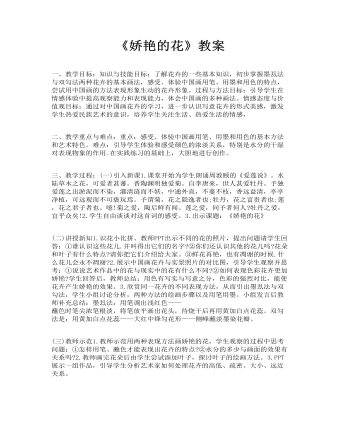
《娇艳的花》教案
二、教学重点与难点:重点:感受、体验中国画用笔、用墨和用色的基本方法和艺术特色。难点:引导学生体验和感受颜色的浓淡关系,特别是水分的干湿对表现物象的作用.在实践练习的基础上,大胆地进行创作。 三、教学过程:(一)引入新课1.课堂开始为学生朗诵周敦颐的《爱莲说》。水陆草木之花,可爱者甚蕃。晋陶渊明独爱菊。自李唐来,世人甚爱牡丹。予独爱莲之出淤泥而不染,濯清涟而不妖,中通外直,不蔓不枝,香远益清,亭亭净植,可远观而不可亵玩焉。予谓菊,花之隐逸者也;牡丹,花之富贵者也;莲,花之君子者也。噫!菊之爱,陶后鲜有闻。莲之爱,同予者何人?牡丹之爱,宜乎众矣!2.学生自由谈谈对这首词的感受。3.出示课题:《娇艳的花》
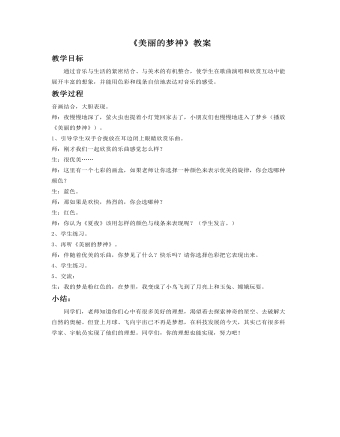
《美丽的梦神》教案
教学过程音画结合,大胆表现。师:夜慢慢地深了,萤火虫也提着小灯笼回家去了,小朋友们也慢慢地进入了梦乡(播放《美丽的梦神》)。1、引导学生双手合拢放在耳边闭上眼睛欣赏乐曲。师:刚才我们一起欣赏的乐曲感觉怎么样?生:很优美……师:这里有一个七彩的画盒,如果老师让你选择一种颜色来表示优美的旋律,你会选哪种颜色?生:蓝色。师:那如果是欢快,热烈的,你会选哪种?生:红色。师:你认为《夏夜》该用怎样的颜色与线条来表现呢?(学生发言。)
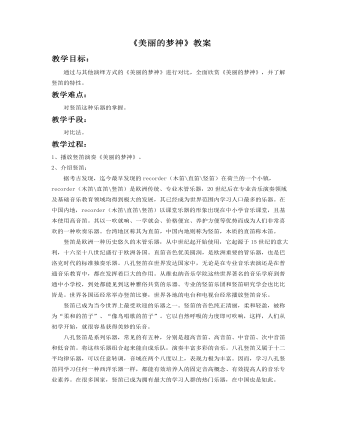
《美丽的梦神》教案
据考古发现,迄今最早发现的recorder(木笛\直笛\竖笛)在荷兰的一个小镇,recorder(木笛\直笛\竖笛)是欧洲传统、专业木管乐器,20世纪后在专业音乐演奏领域及基础音乐教育领域均得到极大的发展,其已经成为世界范围内学习人口最多的乐器。在中国内地,recorder(木笛\直笛\竖笛)以课堂乐器的形象出现在中小学音乐课堂,且基本使用高音笛。其以一吹就响、一学就会、价格便宜、养护方便等优势而成为人们非常喜欢的一种吹奏乐器。台湾地区称其为直笛,中国内地则称为竖笛,木质的直笛称木笛。竖笛是欧洲一种历史悠久的木管乐器,从中世纪起开始使用,它起源于15世纪的意大利,十六至十八世纪盛行于欧洲各国。直笛音色优美圆润,是欧洲重要的管乐器,也是巴洛克时代的标准独奏乐器。八孔竖笛在世界发达国家中,无论是在专业音乐表演还是在普通音乐教育中,都在发挥着巨大的作用。从维也纳音乐学院这些世界著名的音乐学府到普通中小学校,到处都能见到这种雅俗共赏的乐器。专业的竖笛乐团和竖笛研究学会也比比皆是。世界各国还经常举办竖笛比赛,世界各地的电台和电视台经常播放竖笛音乐。
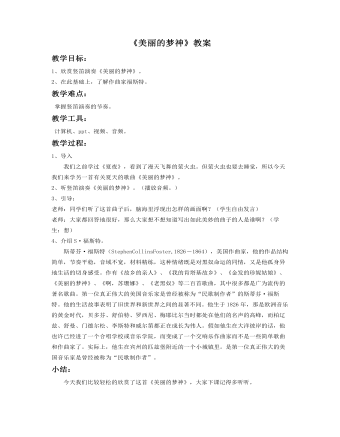
《美丽的梦神》教案
斯蒂芬·福斯特(StephenCollinsFoster,1826-1864),美国作曲家,他的作品结构简单,节奏平稳,音域不宽,材料精练,这种情绪既是对黑奴命运的同情,又是他孤身异地生活的切身感受。作有《故乡的亲人》、《我的肯塔基故乡》、《金发的珍妮姑娘》、《美丽的梦神》、《啊,苏珊娜》、《老黑奴》等二百首歌曲,其中很多都是广为流传的著名歌曲。第一位真正伟大的美国音乐家是曾经被称为“民歌制作者”的斯蒂芬·福斯特。他的生活故事表明了旧世界和新世界之间的显著不同。他生于1826年,那是欧洲音乐的黄金时代,贝多芬、舒伯特、罗西尼、梅耶比尔当时都处在他们的名声的高峰,而柏辽兹、舒曼、门德尔松、李斯特和威尔第都正在成长为伟人。假如他生在大洋彼岸的话,他也许已经进了一个合唱学校或音乐学院,而变成了一个交响乐作曲家而不是一些简单歌曲和作曲家了。实际上,他生在宾州的匹兹堡附近的一个小城镇里。是第一位真正伟大的美国音乐家是曾经被称为“民歌制作者”。